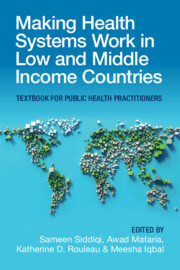 Making Health Systems Work in Low and Middle Income Countries
Making Health Systems Work in Low and Middle Income Countries Book contents
- Making Health Systems Work in Low and Middle Income Countries
- Reviews
- Making Health Systems Work in Low and Middle Income Countries
- Copyright page
- Dedication
- Contents
- About the Editors
- Contributors
- Preface
- Section 1 Analyzing Health Systems: Concepts, Components, Performance
- Chapter 1 Introduction to Health Systems
- Chapter 2 Health Systems Based on Primary Health Care
- Chapter 3 Universal Health Coverage and Health System Strengthening
- Chapter 4 Health System Governance
- Chapter 5 Financing Health Care
- Chapter 6 Health Workforce in Low and Middle Income Countries
- Chapter 7 The Pharmaceutical System and Its Components
- Chapter 8 Health Information Systems
- Chapter 9 The Organization and Management of Health Services
- Chapter 10 Health Services Delivery
- Chapter 11 Role and Contribution of the Community in Health System Strengthening
- Chapter 12 Performing Health Systems
- Chapter 13 Decision-Making Tools for Informed Decisions by Health Policymakers and Managers
- Chapter 14 Health Policy and Systems Research: The Role of Implementation Research
- Section 2 Transforming Health Systems: Confronting Challenges, Seizing Opportunities
- Index
- References
Chapter 8 - Health Information Systems
Data for Decision-Making in Health Systems
from Section 1 - Analyzing Health Systems: Concepts, Components, Performance
Published online by Cambridge University Press: 08 December 2022
- Making Health Systems Work in Low and Middle Income Countries
- Reviews
- Making Health Systems Work in Low and Middle Income Countries
- Copyright page
- Dedication
- Contents
- About the Editors
- Contributors
- Preface
- Section 1 Analyzing Health Systems: Concepts, Components, Performance
- Chapter 1 Introduction to Health Systems
- Chapter 2 Health Systems Based on Primary Health Care
- Chapter 3 Universal Health Coverage and Health System Strengthening
- Chapter 4 Health System Governance
- Chapter 5 Financing Health Care
- Chapter 6 Health Workforce in Low and Middle Income Countries
- Chapter 7 The Pharmaceutical System and Its Components
- Chapter 8 Health Information Systems
- Chapter 9 The Organization and Management of Health Services
- Chapter 10 Health Services Delivery
- Chapter 11 Role and Contribution of the Community in Health System Strengthening
- Chapter 12 Performing Health Systems
- Chapter 13 Decision-Making Tools for Informed Decisions by Health Policymakers and Managers
- Chapter 14 Health Policy and Systems Research: The Role of Implementation Research
- Section 2 Transforming Health Systems: Confronting Challenges, Seizing Opportunities
- Index
- References
Summary
Health information systems (HIS) are crucial for guiding sound public health policies and programs. Information systems are complex entities formed of diverse parts with one common plan and purpose. A critical feature of information systems is that their components have regular interactions and interdependences. The systems should be flexible and adaptable to changes in burden and circumstances. Building health information systems should start by complementing what is currently in place and improving existing systems. It should use new technologies and include training for collectors and users. Most importantly, the data and findings should be rigorously analysed, interpreted, translated, disseminated and used to inform implementation. In this chapter, we provide a brief review of HIS and an example using the Global Burden of Disease as a case study of how different sources of HIS are used to estimate the burden of a disease to guide policies and programs.
Keywords
- Type
- Chapter
- Information
- Making Health Systems Work in Low and Middle Income CountriesTextbook for Public Health Practitioners, pp. 118 - 129Publisher: Cambridge University PressPrint publication year: 2022
